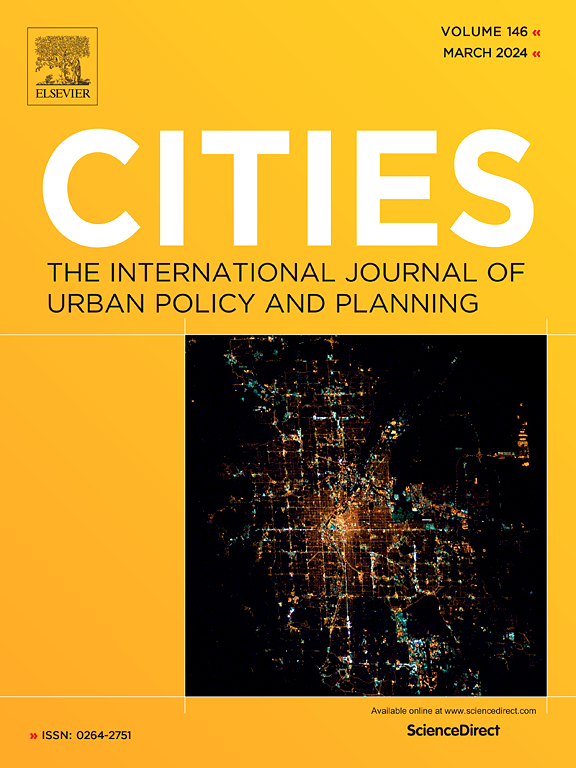Hierarchy of urban road networks from a scaling law perspective
IF 6.6
1区 经济学
Q1 URBAN STUDIES
引用次数: 0
Abstract
The efficient functioning of cities largely relies on their road networks that manifest a rich hierarchical structure, ranging from the highest-level motorways all the way down to the lowest-level footways, much like the vascular networks found in living organisms. As an infrastructure-related indicator, road length theoretically scales sublinearly with the population size of the city, which indicate that roads need to be planned grows slower than the population. However, scaling relations between the length of roads at each hierarchical level and city size remain unclear, which is a crucial practical problem for urban planning. Attribute to collective efforts from millions of volunteers worldwide, detailed hierarchy labels for roads are available from OpenStreetMap, providing a unique opportunity to study this problem. Based on large-scale infrastructure data for more than 1000 cities in the United States and China, we unveil that the total length of roads at most hierarchical levels scales sublinearly with urban population, echoing the economy of scale. However, metro lines and footways are two prominent exceptions that surprisingly manifest a superlinear scaling relation with the population, which signifies a faster growth than the urban population and cannot be explained by current theories. Despite drastic differences in the composition of roads across hierarchies and their spatial connection patterns, it is intriguing that scaling behaviors are quite consistent across these two countries. Such nonlinear urban scaling laws suggest that, for infrastructure planning, using conventional road length per capita can be either biased towards large or small cities, depending on whether the scaling exponent is greater or less than one. Using deviations from urban scaling laws, termed as the scale-adjusted metropolitan indicator (SAMI), which takes off size effect, is a more objective evaluation for whether a city has a shortfall or excess provision of certain types of roads. Furthermore, based on SAMIs across road hierarchy, we identify four groups of cities in the US and three groups of cities in China with distinct average SAMI profiles. In addition, regression analysis further reveals that longer-than-expected residential roads and footways, indicated by positive SAMIs, can help alleviate traffic congestion. By contrast, a longer-than-expected secondary roads might exacerbate it. Our scaling analysis through the lens of hierarchy provides a more comprehensive understanding on the relation between city size and road networks, offering valuable insights for improved urban planning.
尺度律视角下的城市道路网络层次
城市的有效运作在很大程度上依赖于它们的道路网络,这些道路网络表现出丰富的层次结构,从最高级的高速公路一直到最低层的人行道,很像生物体内的血管网络。道路长度作为一项与基础设施相关的指标,理论上与城市人口规模呈亚线性关系,这表明需要规划的道路的增长速度慢于人口的增长速度。然而,各级道路长度与城市规模之间的比例关系尚不清楚,这是城市规划中一个至关重要的实际问题。得益于全球数百万志愿者的共同努力,OpenStreetMap提供了详细的道路等级标签,为研究这一问题提供了独特的机会。基于美国和中国1000多个城市的大规模基础设施数据,我们发现,大多数层级的道路总长度与城市人口呈亚线性关系,这与规模经济相呼应。然而,地铁线路和人行道是两个突出的例外,它们与人口惊人地表现出超线性的比例关系,这意味着比城市人口增长更快,目前的理论无法解释。尽管不同等级的道路组成及其空间连接模式存在巨大差异,但有趣的是,这两个国家的尺度行为相当一致。这种非线性城市标度定律表明,对于基础设施规划,使用传统的人均道路长度可以偏向于大城市或小城市,这取决于标度指数是大于还是小于1。利用偏离城市尺度规律的指标,即规模调整都市指标(SAMI),可以摆脱规模效应,更客观地评价一个城市的某些类型的道路供应是否不足或过剩。此外,基于道路等级的SAMI,我们确定了美国的四组城市和中国的三组城市具有不同的平均SAMI概况。此外,回归分析进一步表明,长预期的住宅道路和人行道,正sami表示,有助于缓解交通拥堵。相比之下,较预期更长时间的二级公路可能会加剧这一问题。我们通过层级视角的尺度分析,对城市规模和道路网络之间的关系提供了更全面的理解,为改进城市规划提供了有价值的见解。
本文章由计算机程序翻译,如有差异,请以英文原文为准。
求助全文
约1分钟内获得全文
求助全文
来源期刊

Cities
URBAN STUDIES-
CiteScore
11.20
自引率
9.00%
发文量
517
期刊介绍:
Cities offers a comprehensive range of articles on all aspects of urban policy. It provides an international and interdisciplinary platform for the exchange of ideas and information between urban planners and policy makers from national and local government, non-government organizations, academia and consultancy. The primary aims of the journal are to analyse and assess past and present urban development and management as a reflection of effective, ineffective and non-existent planning policies; and the promotion of the implementation of appropriate urban policies in both the developed and the developing world.
 求助内容:
求助内容: 应助结果提醒方式:
应助结果提醒方式:


